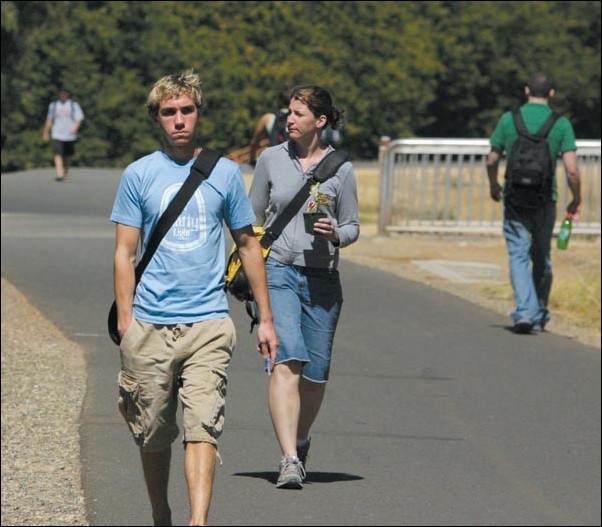Engineers want to strengthen levee
Image: Engineers want to strengthen levee:Eric Oien, a freshman psychology major, joins fellow students using the levee as an alternate route to and from campus. According to the U.S. Army Corps of Engineers, the levee has a very small chance of flooding. Dorie Cook/State Hornet:
September 14, 2005
U.S. Army Corps of Engineers say the chance of a levee failure along the American River adjacent to Sacramento State is extremely small and they are working to make it smaller.
“Last year, after the completion of the work at river mile 6.4 (River Park) and 6.9, just over the levee from campus, the Corps of Engineers certified the levees for the Federal Emergency Management Agency,” said Mark Ellis, American River project manager for the U.S. Army Corps of Engineers. “This revision brought Sac State out of the 100-year floodplain.”
John Johnston, professor of environmental engineering, said a 100-year floodplain is a term used to describe land that would be covered by a flood that has a one percent chance of happening in any one year.
Ellis said the U.S. Army Corps of Engineers is striving to provide 200-plus year protection to Sacramento.
“Two hundred year protection means that they are going for a half percent chance,” Johnston said. “So a flood that would happen on average every 200 years.”
Johnston said though there is no national standard, 200-year protection is typical of what levee engineers shoot for across the nation.
Ellis said a levee breach near Sac State would produce varied results, depending on its size.
“The depth of the water on campus would vary due to the topography of the campus,” Ellis said.
Cyrus Aryani, professor of geotechnical engineering and graduate coordinator, said a major breach in the levee near Sac State would lead to flooding of the campus within a very short period of time, with the campus inundated with several feet of water.
Aryani said in the event of a major levee breach, some areas of Sacramento could be under as much as 20 feet of water. Some areas of Sacramento would drain naturally, but in other areas the water would need to be pumped out.
Ellis said if it were a small, shallow breach it could be blocked with concrete barriers similar to what you see on road construction projects. But if it were a longer, deeper breach it may require the placement of rock to fill in the gap and stop the flow of water.
“There is no single solution for a breach and each one must be independently evaluated,” Ellis said.
As seen recently in New Orleans, where U.S. Army Corps of Engineers crews patched a breach in the levee between the city and Lake Pontchartrain using huge sandbags dropped from a helicopter, similar methods could be used in the event of a breach in the levees along the American River, Aryani said.
If the breach were minor, crews would be able to bring soil material to the breach and use it to fix the breakage point, Aryani said.
Aryani said despite recent improvements made to the levee near the Guy West Bridge, parts of the levee along the American River are still susceptible to failure.
“Improvements do not mean 100 percent protection against floods,” Aryani said. “More work needs to be done.”
Aryani said there are sections of the levees in the Sacramento area that have not been improved, leaving the levees like a chain ?” only as strong as their weakest point.
Since 1986, when Sac State shut down because of fears the American River might breach the levee near campus, there have been episodes of localized flooding in different areas.
Though there have not been any major floods in recent years, floods are still a very minute possibility in this region, Aryani said.
“People should be informed better about flood potential in the Sacramento area,” Aryani said.
Aryani said two possible scenarios that could lead to a levee breach along the American River.
One is seepage, which is the movement of water through the levee from the river side to the dry side. It can cause levee material to wash away, undermining the stability of the levee and leading to eventual overall levee failure.
Another is overtopping, or when water flows over the top of the levee. It can lead to erosion of the levee and eventual levee failure from the bottom of the levee.
Aryani said the recent improvements made to the levee near the Guy West Bridge were made to avoid seepage, but will likely not help in the case of overtopping.
A possible solution to overtopping, Aryani said, would be to raise the levee, making it taller and wider, which he said would require detailed engineering work and would include major modifications of the existing levee.
“It’s a major effort,” Aryani said. “And it requires careful planning.”
Chason Wainwright can be reached at [email protected]
















































































































































